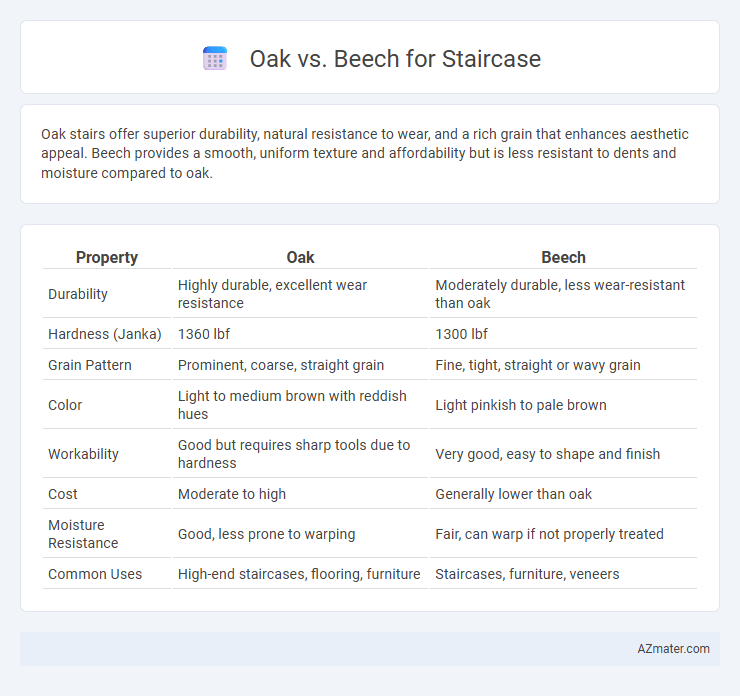Oak stairs offer superior durability, natural resistance to wear, and a rich grain that enhances aesthetic appeal. Beech provides a smooth, uniform texture and affordability but is less resistant to dents and moisture compared to oak.
Table of Comparison
| Property | Oak | Beech |
|---|---|---|
| Durability | Highly durable, excellent wear resistance | Moderately durable, less wear-resistant than oak |
| Hardness (Janka) | 1360 lbf | 1300 lbf |
| Grain Pattern | Prominent, coarse, straight grain | Fine, tight, straight or wavy grain |
| Color | Light to medium brown with reddish hues | Light pinkish to pale brown |
| Workability | Good but requires sharp tools due to hardness | Very good, easy to shape and finish |
| Cost | Moderate to high | Generally lower than oak |
| Moisture Resistance | Good, less prone to warping | Fair, can warp if not properly treated |
| Common Uses | High-end staircases, flooring, furniture | Staircases, furniture, veneers |
Oak vs Beech for Staircases: An Overview
Oak offers superior durability and hardness compared to beech, making it ideal for high-traffic staircases that require long-lasting strength. Beech provides a smoother texture and lighter color, which suits modern interiors and budget-friendly projects but may dent more easily under heavy use. Both woods are popular choices, but oak's resistance to wear and rich grain pattern often makes it the preferred option for staircases demanding robustness and classic aesthetics.
Wood Hardness Comparison: Oak and Beech
Oak, with a Janka hardness rating of approximately 1,290, is significantly harder than Beech, which has a Janka hardness of about 1,300, making both woods durable but Beech slightly softer and more prone to dents. This difference in hardness affects the staircase's resistance to wear and impact, with Oak often preferred for its superior strength and durability in high-traffic areas. Oak's denser grain structure provides enhanced stability and longevity compared to Beech, which may require additional maintenance over time to preserve its appearance.
Visual Appeal: Grain Patterns and Color Differences
Oak staircases feature prominent, open grain patterns with varied textures, lending a rustic and warm aesthetic, while beech offers a finer, more uniform grain that creates a sleek and modern look. Oak's natural color ranges from light honey to deep amber, enhancing its rich, classic appeal, whereas beech presents a pale cream to reddish-brown hue, providing a brighter and more contemporary appearance. The distinct grain and color differences between oak and beech significantly influence the visual impact and style of staircases in interior designs.
Durability and Longevity of Oak and Beech Stairs
Oak stairs offer exceptional durability and longevity due to their dense grain and natural hardness, making them highly resistant to wear and impact over time. Beech stairs, while still strong and reliable, have a slightly softer texture which may show signs of wear faster under heavy foot traffic. Both woods provide solid structural integrity, but oak's superior hardness translates to a longer lifespan in high-usage staircases.
Cost Analysis: Oak vs Beech Staircases
Oak staircases generally command a higher price due to the wood's density, durability, and premium appearance, making them a long-term investment for high-traffic areas. Beech offers a more affordable alternative with good strength and a fine grain, suitable for budget-conscious projects without compromising on quality. The cost difference between oak and beech staircases often stems from the sourcing, finishing requirements, and lifespan, with oak typically requiring less maintenance over time.
Maintenance Requirements for Oak and Beech
Oak staircases require moderate maintenance, needing regular dusting and occasional polishing with wood-specific products to maintain their durability and rich grain. Beech staircases demand more frequent upkeep due to their softer wood, including careful cleaning and protection from moisture to prevent dents and warping. Both woods benefit from prompt stain removal and periodic resealing to preserve their aesthetic appeal and structural integrity.
Workability: Installation and Finishing Differences
Oak offers superior workability for staircases due to its dense grain, allowing precise cuts and smooth sanding, making installation easier for intricate designs. Beech features a fine, even texture that simplifies shaping and reduces the risk of splintering during installation, but it can be harder to stain evenly compared to oak. Finishing oak typically results in a richer, deeper color with enhanced grain visibility, while beech requires more preparation to achieve a uniform finish, often benefiting from sealing or bleaching before staining.
Environmental Impact: Sustainability Factors
Oak and beech differ in environmental impact through their growth rates and carbon sequestration capacities, with beech typically growing faster and thus potentially offering quicker renewable resource cycles. Oak trees generally have higher density wood, which can store more carbon over longer periods, contributing positively to carbon sequestration when used in staircases. Sustainable sourcing certifications like FSC are crucial for both woods to ensure responsible forestry practices that minimize deforestation and promote ecosystem health.
Common Issues and Solutions for Oak and Beech
Oak staircases often face challenges with their hardness, causing difficulties in cutting and shaping, but pre-drilling and sharp tooling effectively mitigate splitting issues. Beech staircases are prone to warping and swelling in humid environments; controlling indoor humidity and applying proper sealants help preserve stability. Both woods may show wear over time, which regular maintenance with suitable finishes can reduce, ensuring durability and aesthetic appeal.
Which is Better for Your Staircase: Oak or Beech?
Oak offers superior durability and a classic, grain-rich appearance that enhances staircase longevity and aesthetic appeal, making it ideal for high-traffic areas. Beech provides a smoother, uniform texture with a lighter color palette, suitable for modern designs but is less resistant to dents and wear compared to oak. Choosing between oak and beech depends on your preference for strength and traditional warmth versus a sleek, contemporary finish with moderate durability.

Infographic: Oak vs Beech for Staircase
 azmater.com
azmater.com